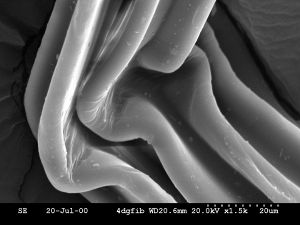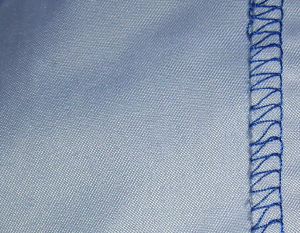Difference between revisions of "Polyester" - New World Encyclopedia
| Line 1: | Line 1: | ||
{{Claimed}} | {{Claimed}} | ||
| − | [[Image:SEMexample.jpg|thumb|[[ | + | [[Image:SEMexample.jpg|thumb|This image, taken with a [[scanning electron microscope]], shows a bend in a high surface area polyester [[fiber]] with a seven-lobed cross section.]] |
| − | '''Polyester''' (aka Terylene) is a | + | '''Polyester''' (aka Terylene) is the name for a class of [[polymer]]s that contain the [[ester]] [[functional group]] in their main chain. Although some types of polyesters can be found in nature, such as the [[cutin]] of [[plant cuticle]]s, the term ''polyester'' is usually applied to the artificially synthesized materials. Among the synthetic types of polyester, one of the most important is known as [[polyethylene terephthalate]] (PET); another is [[polycarbonate]]. |
| − | + | [[Thermoplastic]] polyesters, such as PET, may be heated and processed into different forms, including fibers, sheets, and three-dimensional shapes. Although combustible at high temperatures, polyester tends to shrink away from flames and often self-extinguishes. | |
| − | == | + | == Properties and uses == |
Polyester is the most widely used manufactured fiber in the United States. Woven polyester fabrics are used for apparel and home furnishings. These include bed sheets, bedspreads, curtains and draperies. Polyester fiberfill is also used to stuff pillows, comforters and cushion padding. | Polyester is the most widely used manufactured fiber in the United States. Woven polyester fabrics are used for apparel and home furnishings. These include bed sheets, bedspreads, curtains and draperies. Polyester fiberfill is also used to stuff pillows, comforters and cushion padding. | ||
| − | Polyester fabrics sometimes have a "less natural" feel when compared to similarly woven fabrics made from natural fibers, | + | Polyester fabrics sometimes have a "less natural" feel when compared to similarly woven fabrics made from natural fibers, such as cotton. However, polyester fabrics may exhibit other advantages over natural fabrics, particularly improved wrinkle resistance. For this reason, polyester fibers are often spun together with natural fibers, such as [[cotton]], to produce cloth with blended properties. |
| − | |||
| − | + | [[Image:Polyester Shirt, close-up.jpg|thumb|Close-up of a polyester shirt.]] | |
| − | + | Polyesters are also used to make [[bottle]]s, [[film]]s, [[tarpaulin]], [[liquid crystal display]]s, [[hologram]]s, [[filter (chemistry)|filter]]s, [[dielectric]] film for [[capacitor]]s, [[Electrical insulation|film insulation]] for [[wire]], and insulating tapes. | |
| − | + | Liquid crystalline polyesters are among the first such polymers to be used industrially. In general, they have extremely good mechanical properties and are very resistant to heat. They can therefore be used for seals in jet engines. | |
| − | Polyester is also widely used as a finish on high-quality wooden products like [[guitar]]s, [[piano]]s and vehicle/yacht interiors | + | [[Thermoset]]ting polyester [[resin]]s are generally copolymers of unsaturated polyesters with styrene.<ref>In organic chemistry, an "unsaturated" molecule is one that contains double or triple covalent bonds between carbon atoms.</ref> The unsaturation in the polyester is generally obtained by the use of maleic acid or fumaric acid, each of which has a carbon-carbon double bond in its molecular structure. Another important family is the group of vinyl esters. Here the unsaturation is found in the alcohol part of the polyester. The double bond of the unsaturated polyester reacts with styrene resulting in a 3-D crosslinked structure, the thermoset material. Unsaturated polyesters are commonly used as [[casting]] materials, [[fiberglass]] laminating resins, and non-metallic auto-body fillers. Fiberglass reinforced unsaturated polyesters find wide application in the bodies of yachts and automobiles. |
| + | |||
| + | Polyester is also widely used as a finish on high-quality wooden products like [[guitar]]s, [[piano]]s and vehicle/yacht interiors.<ref>[[Burns London|Burns Guitars]], [[Rolls-Royce car|Rolls Royce]], and [[Sunseeker]] are examples of companies that use polyester on their products.</ref> The [[thixotropic]] properties of the sprayable form of polyester make it ideal for use on open-grain timbers, as it can quickly fill the grain and has a high build film thickness per coat. The cured polyester can then be sanded and polished to a high-gloss, durable finish. | ||
==Synthesis== | ==Synthesis== | ||
| − | Synthesis of polyesters is generally achieved by a | + | |
| + | Synthesis of polyesters is generally achieved by what are called polycondensation reactions.<ref>In a "condensation reaction," two [[molecule]]s (or [[functional group]]s) combine to form a single molecule, accompanied by the loss of a small molecule, such as water.</ref> Some examples of these reactions are given below. | ||
===Azeotrope esterification=== | ===Azeotrope esterification=== | ||
| − | In this classical method, an [[alcohol]] and a [[carboxylic acid]] react to form a carboxylic ester. | + | |
| − | To assemble | + | In this classical method, an [[alcohol]] and a [[carboxylic acid]] react to form a carboxylic ester, with the release of water molecules. To assemble the polymer, the water formed by the reaction must be continually removed, by a process known as [[azeotrope]] distillation. |
===Alcoholic transesterification=== | ===Alcoholic transesterification=== | ||
| − | |||
{| | {| | ||
| Line 53: | Line 54: | ||
===Acylation (HCl method)=== | ===Acylation (HCl method)=== | ||
| − | The acid begins as an acid chloride, and thus the polycondensation proceeds with emission of [[hydrochloric acid]] (HCl) instead of water. | + | |
| + | The acid begins as an acid chloride, and thus the polycondensation proceeds with emission of [[hydrochloric acid]] (HCl) instead of water. This method can be carried out in solution or as an [[vitreous enamel|enamel]]. | ||
| + | |||
:'''Silyl method''' | :'''Silyl method''' | ||
:In this variant of the HCl method, the carboxylic acid chloride is converted with the trimethyl silyl ether of the alcohol component; trimethyl silyl chloride is produced. | :In this variant of the HCl method, the carboxylic acid chloride is converted with the trimethyl silyl ether of the alcohol component; trimethyl silyl chloride is produced. | ||
Revision as of 14:48, 23 September 2007

Polyester (aka Terylene) is the name for a class of polymers that contain the ester functional group in their main chain. Although some types of polyesters can be found in nature, such as the cutin of plant cuticles, the term polyester is usually applied to the artificially synthesized materials. Among the synthetic types of polyester, one of the most important is known as polyethylene terephthalate (PET); another is polycarbonate.
Thermoplastic polyesters, such as PET, may be heated and processed into different forms, including fibers, sheets, and three-dimensional shapes. Although combustible at high temperatures, polyester tends to shrink away from flames and often self-extinguishes.
Properties and uses
Polyester is the most widely used manufactured fiber in the United States. Woven polyester fabrics are used for apparel and home furnishings. These include bed sheets, bedspreads, curtains and draperies. Polyester fiberfill is also used to stuff pillows, comforters and cushion padding.
Polyester fabrics sometimes have a "less natural" feel when compared to similarly woven fabrics made from natural fibers, such as cotton. However, polyester fabrics may exhibit other advantages over natural fabrics, particularly improved wrinkle resistance. For this reason, polyester fibers are often spun together with natural fibers, such as cotton, to produce cloth with blended properties.
Polyesters are also used to make bottles, films, tarpaulin, liquid crystal displays, holograms, filters, dielectric film for capacitors, film insulation for wire, and insulating tapes.
Liquid crystalline polyesters are among the first such polymers to be used industrially. In general, they have extremely good mechanical properties and are very resistant to heat. They can therefore be used for seals in jet engines.
Thermosetting polyester resins are generally copolymers of unsaturated polyesters with styrene.[1] The unsaturation in the polyester is generally obtained by the use of maleic acid or fumaric acid, each of which has a carbon-carbon double bond in its molecular structure. Another important family is the group of vinyl esters. Here the unsaturation is found in the alcohol part of the polyester. The double bond of the unsaturated polyester reacts with styrene resulting in a 3-D crosslinked structure, the thermoset material. Unsaturated polyesters are commonly used as casting materials, fiberglass laminating resins, and non-metallic auto-body fillers. Fiberglass reinforced unsaturated polyesters find wide application in the bodies of yachts and automobiles.
Polyester is also widely used as a finish on high-quality wooden products like guitars, pianos and vehicle/yacht interiors.[2] The thixotropic properties of the sprayable form of polyester make it ideal for use on open-grain timbers, as it can quickly fill the grain and has a high build film thickness per coat. The cured polyester can then be sanded and polished to a high-gloss, durable finish.
Synthesis
Synthesis of polyesters is generally achieved by what are called polycondensation reactions.[3] Some examples of these reactions are given below.
Azeotrope esterification
In this classical method, an alcohol and a carboxylic acid react to form a carboxylic ester, with the release of water molecules. To assemble the polymer, the water formed by the reaction must be continually removed, by a process known as azeotrope distillation.
Alcoholic transesterification
O
\\
C - OCH3 + OH[Oligomer2]
/
[Oligomer1]
|
O
\\
C - O[Oligomer2] + CH3OH
/
[Oligomer1]
| |
| (ester-terminated oligomer + alcohol-terminated oligomer) | (larger oligomer + methanol) |
Acylation (HCl method)
The acid begins as an acid chloride, and thus the polycondensation proceeds with emission of hydrochloric acid (HCl) instead of water. This method can be carried out in solution or as an enamel.
- Silyl method
- In this variant of the HCl method, the carboxylic acid chloride is converted with the trimethyl silyl ether of the alcohol component; trimethyl silyl chloride is produced.
Acetate method (esterification)
- Silyl acetate method
Ring-opening Polymerization
Aliphatic polyesters can be assembled from lactones under very mild conditions, catalyzed anionically, cationically or metallorganically.
See also
ReferencesISBN links support NWE through referral fees
- Albertsson, Ann-Christine. 2002. Degradable Aliphatic Polyesters. Advances in Polymer Science, 157. Berlin: Springer. ISBN 3540422498.
- Goodman, Isaac, and Brian Parkyn. 1965. Polyesters. London: Published for the Plastics Institute by Iliffe Books. OCLC 2033281.
- Kadolph, Sara J. 2007. Textiles. Upper Saddle River, NJ: Pearson Prentice Hall. ISBN 9780131187696.
- Scheirs, John, and Timothy E. Long, eds. 2003. Modern Polyesters: Chemistry and Technology of Polyesters and Copolyesters. Wiley Series in Polymer Science. Hoboken, NJ: John Wiley & Sons. ISBN 0471498564.
| |||||||||
| ||||||||||
Credits
New World Encyclopedia writers and editors rewrote and completed the Wikipedia article in accordance with New World Encyclopedia standards. This article abides by terms of the Creative Commons CC-by-sa 3.0 License (CC-by-sa), which may be used and disseminated with proper attribution. Credit is due under the terms of this license that can reference both the New World Encyclopedia contributors and the selfless volunteer contributors of the Wikimedia Foundation. To cite this article click here for a list of acceptable citing formats.The history of earlier contributions by wikipedians is accessible to researchers here:
The history of this article since it was imported to New World Encyclopedia:
Note: Some restrictions may apply to use of individual images which are separately licensed.
- ↑ In organic chemistry, an "unsaturated" molecule is one that contains double or triple covalent bonds between carbon atoms.
- ↑ Burns Guitars, Rolls Royce, and Sunseeker are examples of companies that use polyester on their products.
- ↑ In a "condensation reaction," two molecules (or functional groups) combine to form a single molecule, accompanied by the loss of a small molecule, such as water.


